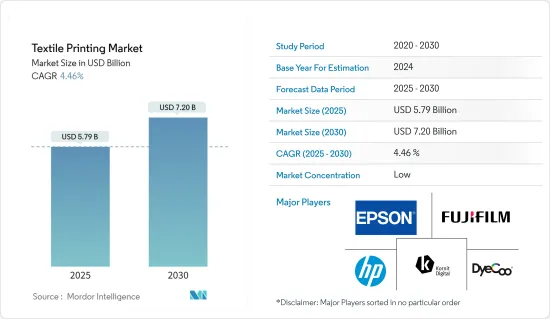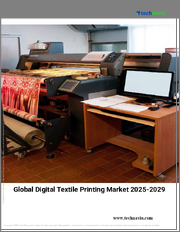
|
시장보고서
상품코드
1636581
날염 시장 : 점유율 분석, 산업 동향 및 통계, 성장 예측(2025-2030년)Textile Printing - Market Share Analysis, Industry Trends & Statistics, Growth Forecasts (2025 - 2030) |
||||||
날염 시장 규모는 2025년에 57억9,000만 달러로 추정되고, 예측기간(2025-2030년)의 CAGR은 4.46%로 전망되며, 2030년에는 72억 달러에 달할 것으로 예측됩니다.

날염 시장은 기술의 진보와 전자상거래 및 고속 패션의 성장으로 가속화된 맞춤형 고품질 원단에 대한 수요가 증가함에 따라 빠르게 진화하고 있습니다. 주요 동향으로는 기존의 방법보다 유연성과 효율성이 뛰어난 디지털 프린트 기술의 채용이 증가하고 있는 것을 들 수 있습니다.
2024년 1월 현재 디지털 날염은 섬유 생산 및 수출의 주요 거점인 중국의 장강 델타 지역에 크게 진출하고 있습니다. 이 방식은 잉크젯 기술을 채용하고 있어 직물에 정확하고 생생한 디자인을 실시하는 동시에, 환경 친화적인 기술에 의해 환경에 대한 영향을 최소한으로 억제할 수 있습니다.
AI를 탑재한 디자인 툴과 지속 가능한 인쇄 방법 등의 혁신도 업계를 재구축하고 있습니다. 2024년 5월 28일부터 6월 7일까지 뒤셀도르프에서 열린 Drupa 무역 박람회에서 Messe Dusseldorf는 'Drupa Next Age' 포럼의 일환으로 Drupa Imaging Summit을 소개했습니다. 이 정상 회담에서는 유명한 업계 리더가 영상 기술과 인쇄에 대한 인공지능(AI)의 영향을 논의했습니다.
주목할만한 프레젠테이션에는 AI가 이미지 제작에 어떤 변화를 가져올지 강조한 Google Cloud의 Dennis Oberfeld와 이미지 제작의 현재 AI 도구와 그 용도에 대한 인사이트를 제공하는 AI Imagelab의 Andreas Jurgensen이 포함됩니다.
날염 시장 동향
H&M과 교세라, 크리에이터와 환경을 위한 날염 혁신 발표
2023년 10월 H&M 그룹이 소유한 온디맨드 날염 플랫폼인 Creator Studio는 소비자가 맞춤형 그래픽을 만들고 인쇄할 수 있는 AI를 탑재한 솔루션을 발표했습니다. 이 혁신은 H&M공급망과 완성 능력을 활용하고 지속가능하고 고품질의 제품을 제공함으로써 제작자에게 힘을 주고 컨텐츠 제작 프로세스를 간소화하는 것을 목표로 합니다. COS, Monki, &Other Stories 등의 브랜드를 소유한 H&M은 AI를 통합하여 조달 및 판매 데이터를 최적화함으로써 기술 중심의 접근 방식을 강화하고 있습니다.
2024년 2월 교세라는 수질 오염과 이산화탄소 배출과 같은 섬유 산업의 환경 과제를 해결하기 위해 설계된 잉크젯 프린터 'Forearth'를 발표했습니다. 이 프린터는 직물과 물 사용으로 인한 영향을 최소화하여 폐기물을 줄이기 위한 것입니다.
교세라의 다니구치 쇼 부본부장은 세탁에 의해 연간 500억개의 페트병에 상당하는 마이크로 화이버가 바다에 방출되고 있는 것을 들고, 섬유 오염의 심각성을 강조합니다. Forearth는 인쇄를 진화시켜 패션 산업의 환경 발자국을 줄이는 유망한 솔루션을 제공합니다.
베트남 직물에 대한 왕성한 수요는 날염 산업의 성장 기회를 나타냅니다.
업계 데이터에 따르면 2022년 베트남은 인공 섬유 소재를 사용한 직물을 약 45억 7,000만 달러 상당 수입해, 이 카테고리에서 세계 최대의 수입국이 되었습니다. 방글라데시가 약 21억 4,000만 달러로 2위 수입국으로 이어집니다. 이 직물의 2022년 세계 총 수입액은 401억 달러였습니다.
이 대규모 수입액은 베트남의 왕성한 섬유자재 수요를 돋보이게 하고, 이 나라를 세계 섬유 시장에서 중요한 기업으로 자리매김하고 있습니다. 이 왕성한 수요는 국내 및 국제 시장을 위한 고급 인쇄 솔루션을 필요로 하는 활발한 의류 제조 부문에 견인되어 날염 산업에 큰 잠재력을 보여줍니다. 베트남이 섬유 생산의 중심지로 계속 발전함에 따라 날염 시장은 고품질 인쇄 원단에 대한 수요 증가에 대응하고 성장과 혁신을 위한 큰 기회를 얻을 것으로 기대됩니다.
베트남 중부의 주요 자동 인쇄 회사인 Duy Tran은 이러한 가능성의 한 예입니다. 이 회사는 주요 의류 및 섬유 제조 업체에 서비스를 제공하고 50개 이상의 세계 브랜드와 500개 이상의 프로젝트에 종사하고 300명 이상의 숙련공을 고용하고 있습니다. Duy Tran의 기술적 진보와 능력은 현지 수요와 국제 파트너십에 힘입어 베트남의 날염 시장에서 급성장하는 기회를 돋보이게 합니다.
날염 산업 개요
날염 시장은 치열한 경쟁을 벌이고 있으며, 대기업은 시장 점유율을 얻고 기술 혁신의 선진을 끊기 위해 다양한 전략을 채택하고 있습니다. 이 분야의 주요 기업으로는 엡손, Kornit Digital, 후지 필름, DyeCoo Textile Systems 등이 있습니다. 이 회사들은 광범위한 인쇄 요구 사항을 충족하는 고성능, 맞춤형 인쇄 프린터를 강조합니다.
엡손은 Innovation Center Building B에서 디지털 인쇄 인쇄의 실력을 강화하고 SureColor F 시리즈 프린터에서 높은 생산성과 친환경을 선호합니다. 코니트 디지털은 온디맨드, 지속가능한 인쇄 솔루션에 중점을 두고, 직접 투 가먼트 및 직접 투 패브릭 용도를 위한 고성능 프린터를 자랑합니다. 한편, DyeCoo Textile Systems는 물 없는 염색 기술을 지지하고 환경에 미치는 영향을 줄이는 것을 목표로 하고 있습니다.
기타 혜택 :
- 엑셀 형식 시장 예측(ME) 시트
- 3개월간의 애널리스트 서포트
목차
제1장 서론
- 조사의 성과
- 조사의 전제
- 조사 범위
제2장 조사 방법
- 분석 방법
- 조사 단계
제3장 주요 요약
제4장 시장 인사이트
- 현재의 시장 시나리오
- 기술 동향
- 공급망 및 밸류체인 분석에 대한 인사이트
- 업계 규제에 관한 인사이트
- 업계의 기술적 진보에 관한 인사이트
제5장 시장 역학
- 시장 성장 촉진요인
- 커스터마이즈 수요 증가
- 전자상거래 성장
- 시장 성장 억제요인
- 고액의 초기 투자
- 환경에 대한 우려
- 시장 기회
- 지속 가능한 인쇄 솔루션
- 스마트 텍스타일 통합
- 업계의 매력-Porter's Five Forces 분석
- 신규 참가업체의 위협
- 구매자 및 소비자의 협상력
- 공급기업의 협상력
- 대체품의 위협
- 경쟁 기업간 경쟁 관계의 강도
제6장 시장 세분화
- 인쇄 기술별
- 스크린 인쇄
- 디지털 인쇄
- 열전사 인쇄
- 기타(블록, 스텐실 등)
- 용도별
- 패션 및 의류
- 공업용 섬유
- 홈 섬유 및 기타
- 지역별
- 북미
- 유럽
- 아시아태평양
- 남미
- 중동 및 아프리카
제7장 경쟁 구도
- 시장 집중도 개요
- 기업 프로파일
- Epson
- Kornit Digital
- Fujifilm
- DyeCoo Textile Systems
- HP Inc.
- Roland DG
- MS Printing Solutions
- Mimaki
- Spoonflower
- Juki Corporation*
- 기타 기업
제8장 시장 기회 및 향후 동향
제9장 부록
AJY 25.02.12The Textile Printing Market size is estimated at USD 5.79 billion in 2025, and is expected to reach USD 7.20 billion by 2030, at a CAGR of 4.46% during the forecast period (2025-2030).

The textile printing market is rapidly evolving, driven by technological advancements and the rising demand for customized, high-quality fabrics spurred by e-commerce and fast fashion growth. Key trends include the increasing adoption of digital printing technologies, which offer greater flexibility and efficiency than traditional methods.
As of January 2024, digital fabric printing is making significant inroads in China's Yangtze River Delta region, a primary textile production and export hub. This method employs inkjet technology, allowing for precise, vibrant designs on fabric while minimizing environmental impact through its eco-friendly technologies.
Innovations such as AI-powered design tools and sustainable printing practices are also reshaping the industry. At the Drupa trade fair in Dusseldorf, held from May 28 to June 7, 2024, Messe Dusseldorf introduced the Drupa Imaging Summit as part of the "Drupa Next Age" forum. The summit featured prominent industry leaders discussing the impact of artificial intelligence (AI) on imaging technologies and printing.
Notable presentations included Dennis Oberfeld from Google Cloud, who highlighted how AI is transforming image creation, and Andreas Jurgensen of AI Imagelab, who offered insights into current AI tools and their applications in image production.
Textile Printing Market Trends
H&M and Kyocera Launch Fabric Printing Innovations for Creators and Environment
In October 2023, Creator Studio, an on-demand fabric printing platform owned by the H&M group, launched an AI-powered solution that allows consumers to create and print customized graphics. This innovation aims to empower creators and streamline the content creation process, utilizing H&M's supply chain and fulfillment capabilities to offer sustainable and high-quality products. H&M, which owns brands like COS, Monki, and & Other Stories, is enhancing its technology-driven approach by integrating AI to optimize sourcing and sales data.
In February 2024, Kyocera introduced the Forearth inkjet printer, designed to address the textile industry's environmental challenges, such as water pollution and carbon emissions. The printer aims to reduce waste by minimizing the impact of fabric and water use.
Kyocera's deputy general manager, Sho Taniguchi, emphasizes the severity of textile pollution, citing that washing clothes releases microfibers equivalent to 50 billion plastic bottles into the ocean annually. Forearth offers a promising solution to decrease the fashion industry's environmental footprint by advancing textile printing practices.
Vietnam's Robust Demand for Woven Fabrics Signals Growth Opportunities in Textile Printing Industry
According to industry data, in 2022, Vietnam imported approximately USD 4.57 billion worth of woven fabrics made from man-made textile materials, making it the largest importer in this category globally. Bangladesh followed as the second largest importer, with around USD 2.14 billion. These fabrics' total global import value was USD 40.1 billion in 2022.
This substantial import value underscores Vietnam's robust demand for textile materials, positioning the country as a critical player in the global textile market. This strong demand indicates significant potential for the textile printing industry, driven by a thriving garment manufacturing sector requiring advanced printing solutions for domestic and international markets. As Vietnam continues to develop as a central textile production hub, the textile printing market is expected to see substantial opportunities for growth and innovation, catering to the increasing demand for high-quality printed fabrics.
Duy Tran, a leading automated printing enterprise in central Vietnam, is an example of this potential. The company serves major garment and textile manufacturers, working with over 50 global brands on over 500 projects and employing over 300 skilled workers. Duy Tran's technical advancement and capacity highlight the burgeoning opportunities within Vietnam's textile printing market, driven by local demand and international partnerships.
Textile Printing Industry Overview
The textile printing market is fiercely competitive, with leading players adopting diverse strategies to seize market share and spearhead innovation. Key players in this arena include Epson, Kornit Digital, Fujifilm, and DyeCoo Textile Systems. These players emphasize high-performance, customizable textile printers that cater to a broad spectrum of textile printing requirements.
Epson is bolstering its digital textile printing prowess at Innovation Center Building B, prioritizing high productivity and eco-friendliness with its SureColor F-Series printers. Kornit Digital focuses on on-demand, sustainable printing solutions, boasting high-performance printers for direct-to-garment and direct-to-fabric applications. Fujifilm harnesses its imaging expertise to deliver top-notch digital textile printers, whereas DyeCoo Textile Systems champions waterless dyeing technology, aiming to mitigate environmental repercussions.
Additional Benefits:
- The market estimate (ME) sheet in Excel format
- 3 months of analyst support
TABLE OF CONTENTS
1 INTRODUCTION
- 1.1 Study Deliverables
- 1.2 Study Assumptions
- 1.3 Scope of the Study
2 RESEARCH METHODOLOGY
- 2.1 Analysis Methodology
- 2.2 Research Phases
3 EXECUTIVE SUMMARY
4 MARKET INSIGHTS
- 4.1 Current Market Scenario
- 4.2 Technological Trends
- 4.3 Insights on Supply Chain/Value Chain Analysis
- 4.4 Insights into Governement Regualtions in the Industry
- 4.5 Insights into Technological Advancements in the Industry
5 MARKET DYNAMICS
- 5.1 Market Drivers
- 5.1.1 Increasing Demand for Customization
- 5.1.2 Growth in E-commerce
- 5.2 Market Restraints
- 5.2.1 High Initial Investment
- 5.2.2 Environmental Concerns
- 5.3 Market Opportunities
- 5.3.1 Sustainable Printing Solutions
- 5.3.2 Integration of Smart Textiles
- 5.4 Industry Attractiveness - Porter's Five Forces Analysis
- 5.4.1 Threat of New Entrants
- 5.4.2 Bargaining Power of Buyers/Consumers
- 5.4.3 Bargaining Power of Suppliers
- 5.4.4 Threat of Substitute Products
- 5.4.5 Intensity of Competitive Rivalry
6 MARKET SEGMENTATION
- 6.1 By Printing Technology
- 6.1.1 Screen Printing
- 6.1.2 Digital Printing
- 6.1.3 Heat Transfer Printing
- 6.1.4 Others (Block, Stencil etc)
- 6.2 By Application
- 6.2.1 Apparel/ Clothing
- 6.2.2 Technical/ Industrial Textile
- 6.2.3 Home Textile & Others
- 6.3 By Region
- 6.3.1 North America
- 6.3.2 Europe
- 6.3.3 Asia Pacific
- 6.3.4 South America
- 6.3.5 Middle East & Africa
7 COMPETITIVE LANDSCAPE
- 7.1 Market Concentration Overview
- 7.2 Company Profiles
- 7.2.1 Epson
- 7.2.2 Kornit Digital
- 7.2.3 Fujifilm
- 7.2.4 DyeCoo Textile Systems
- 7.2.5 HP Inc.
- 7.2.6 Roland DG
- 7.2.7 MS Printing Solutions
- 7.2.8 Mimaki
- 7.2.9 Spoonflower
- 7.2.10 Juki Corporation*
- 7.3 Other Companies



















